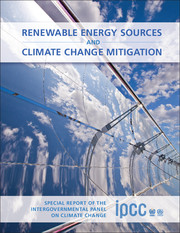 Renewable Energy Sources and Climate Change Mitigation
Renewable Energy Sources and Climate Change Mitigation Book contents
- Frontmatter
- Contents
- Section I
- Section II
- Section III
- Section IV
- Annex I Glossary, Acronyms, Chemical Symbols and Prefixes
- Annex II Methodology
- Annex III Recent Renewable Energy Cost and Performance Parameters
- Annex IV Contributors to the IPCC Special Report
- Annex V Reviewers of the IPCC Special Report
- Annex VI Permissions to Publish
- Index
Annex I - Glossary, Acronyms, Chemical Symbols and Prefixes
Published online by Cambridge University Press: 05 December 2011
- Frontmatter
- Contents
- Section I
- Section II
- Section III
- Section IV
- Annex I Glossary, Acronyms, Chemical Symbols and Prefixes
- Annex II Methodology
- Annex III Recent Renewable Energy Cost and Performance Parameters
- Annex IV Contributors to the IPCC Special Report
- Annex V Reviewers of the IPCC Special Report
- Annex VI Permissions to Publish
- Index
Summary
Glossary entries (highlighted in bold) are by preference subjects; a main entry can contain subentries, in bold italic, for example, Final Energy is defined under the entry Energy. The Glossary is followed by a list of acronyms/abbreviations, a list of chemical names and symbols, and a list of prefixes (international standard units). Some definitions are adapted from C.J. Cleveland and C. Morris, 2006: Dictionary of Energy, Elsevier, Amsterdam. Definitions of regions and country groupings are given in Section A.II.6 of Annex II of this report.
Glossary
Adaptation: Initiatives and measures to reduce the vulnerability or increase the resilience of natural and human systems to actual or expected climate change impacts. Various types of adaptation exist, for example, anticipatory and reactive, private and public, and autonomous and planned. Examples are raising river or coastal dikes, retreating from coastal areas subject to flooding from sea level rise or introducing alternative temperature-appropriate or drought-adapted crops for conventional ones.
Aerosols: A collection of airborne solid or liquid particles, typically between 0.01 and 10 μm in size and residing in the atmosphere for at least several hours. Aerosols may be of natural or anthropogenic origin. See also black carbon.
Afforestation: Direct human-induced conversion of land that has not been forested historically to forested land through planting, seeding and/or the human-induced promotion of natural seed sources. See also deforestation, reforestation, land use.
- Type
- Chapter
- Information
- Renewable Energy Sources and Climate Change MitigationSpecial Report of the Intergovernmental Panel on Climate Change, pp. 953 - 972Publisher: Cambridge University PressPrint publication year: 2011
- 5
- Cited by
